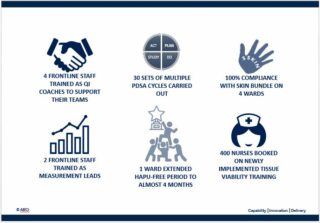Q Exchange
Storytelling for improvement using data, pictures and words
- Idea
- 2018

Meet the team: #StorytellingForQI
Also:
- John Boulton, Executive Director of Aneurin Bevan Continuous Improvement (ABCi), Aneurin Bevan University Health Board
- Benna Waites, Joint Head of Psychology Counselling and Arts Therapies, Psychology, Aneurin Bevan University Health Board
- Sara Long, Welsh Clinical Leadership Training Fellow, Aneurin Bevan Continuous Improvement (ABCi), Aneurin Bevan University Health Board
The appropriate use of visual information, whether data, pictures or words, all contribute to the development of communication strategies which, in turn facilitate understanding of ‘why we are doing what we are doing’ and hence lead to large scale change and impact.
Acknowledging and understanding different “People Styles at Work” (Robert Bolton & Dorothy Grover Bolton, AMACOM, NY, 2009) helps us to make “bad relationships good and good relationships better”. Crudely categorising the behavioural styles of people into four groups allows us to observe and understand the mode and speed at which people “make decisions, […] manage time and stress and deal with conflict”. What has not been investigated so far, is whether (and how) Analysts, Drivers, Amiables and Expressives are already significantly different in how they grasp information — which then manifests in the observed heterogeneity when it comes to decision-making.
This project will focus on how individuals with different behavioural styles perceive and communicate data, pictures and words differently and complements the decision what type of visual display is most appropriate. In fact, we seek to go beyond the “control chart or slope graph?” discussion and aim at understanding how the information the selected chart conveys has to be presented to reach the targeted audience. Understanding ‘who we talk to’ (in terms of working style) then helps to reduce miscommunication and increase engagement. (‘Who’ can be anybody — improvers, colleagues, frontline staff or our patients.)
Initially a study will be carried out where participants are asked to review pieces of visual information whilst undertaking a “people styles at work” questionnaire to assess where they ‘fit in’. In a standardised way, this will look at perception of information in terms of arrangement in space, sequencing of information, considering what formats or representations including colour and other pre-attentive attributes appear to be credible and/or informative. We have already considered the ethical implications of this trial, and this has been approved by R&D under the category of a service improvement project. The outcomes of our study will be reviewed in conjunction with science of improvement, psychology and communications literature to build guidelines for improvers. These guidelines are set up to also address learning preferences. Ultimately this will enable us to develop a resource that is both accessible and easy-to-use for improvers. This will empower improvement teams to tell stories using visual information in a way that increases understanding and engagement. This supports
- reducing cognitive load when confronted with information (in particular graphs in presentations, reports and dashboards),
- promoting the understanding of complicated concepts by providing explanatory rather than explorative charts,
- building knowledge by understanding the core messages,
- developing effective communication strategies and
- facilitating appropriate decision-making.
How you can contribute
- Feedback
- Test some of our theories in practice (and becoming part of the study)
Comments
Mark McCrory 16 Jun 2018
This sounds like a fascinating project which could help overcome communication barriers and really improve understanding. It reminds me a little of learning styles around how research shows that people have distinct learning preferences (e.g. visual, auditory or kinesthetic) and while matching learning methods to style is important, more recent research suggests it is also important to ensure a match between the learning method to the topic/task being taught. Could that be something to consider in your study e.g. in addition to the interaction of personal style and type of visual information, is the visual information 'matched' to the best way of presenting that particular piece of information?
Tracey England 7 Jun 2018
This is a brilliant idea. The way that people understand and communicate in an organisation is so important; so knowing the way that people interpret information is crucial. I think that this will be a fantastic resource.
Rachel Fletcher 7 Jun 2018
Really excited about this piece of work and it's great to read your comments about it. Lets make this a true Q Community experience: building knowledge around how we engage others in our improvement efforts using communication and psychology, through data prictures and words
Ana Llewellyn 4 Jun 2018
Very much looking forward to 'seeing' the outcomes from your project. Good luck.
Mirek Skrypak 24 May 2018
This projects sounds very interesting (great idea) and certainly one that would/could definitely work with/align with our idea https://q.health.org.uk/idea/speed-dataing/ . Perhaps we could test some theories through application in practice through our visualisations and also our associated app? We could then provide feedback/work on next iteration?
Doris Behrens 24 May 2018
Thank you Kate and Thomas, for your encouraging comments! Delighted to have found someone to come back to when we launch testing some of our hypothesis :). Maybe your impressive #plotthedots community would be a nice test bed ...
Thomas Weijburg 23 May 2018
Very interesting take - I cannot wait to see and learn more from you
Kate Cheema 22 May 2018
Great synergy here with some of the themes underpinning Making Data Count- really interested in the results from your questionnaire and would be delighted to test some of this in practice when presenting data to various audiences.
All the best!
Kate
Comments are now closed for this post.